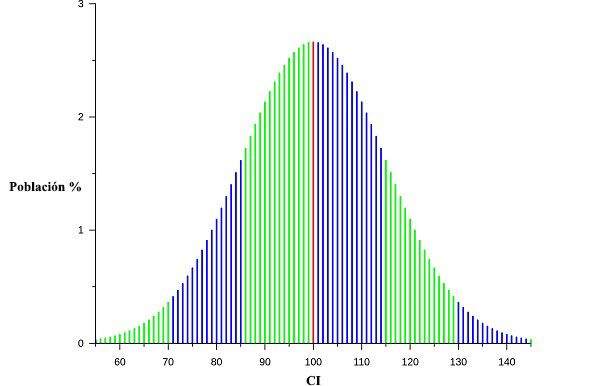What is the IC (intellectual quotient or IQ) and how it is measured? Discover your true potential

- 4313
- 649
- John Von
Content
Toggle- What is the intellectual quotient?
- How the CI number is obtained
- Do you want to know your ci? Do our intelligence test and discover your true potential
- Origin of intelligence tests
- WAIS test tests measure
- Ranges of the scores established to measure the IC
- Factors that influence the intellectual quotient
- Age and Ci
- Average by age
- Criticism of the concept of CI
- Conclusions
- Videos on the intellectual quotient
- Bibliographic references
What is the intellectual quotient?
The IC is the result of a standardized examination that measures the cognitive skills and intellectual capacity of a person in relation to his age group. Do you wonder how that number is obtained? Are you interested in knowing more about how it is used in school and clinical psychology? Reading to learn more about the IC and its importance in the measurement of human intelligence!
How the CI number is obtained
Many times we will have seen or heard that the IC is the intelligence quotient, But in reality that would not be the correct term, although it is valid, since the figure obtained to measure the IC derives from the arithmetic operation that is obtained by dividing one amount (dividend) by another (divisor), so that the result It is the quotient.
He intellectual quotient is obtained by division between the mental age of an individual (which are the results offered by intelligence tests) and His chronological age, multiplied by one hundred.
The average IC of an age group has been set at 100 points, and all those scores that are between 90 and 110 are considered within the normal parameters. The tests are designed so that the distribution of the results is a Gaussian distribution, that is, to follow the Campana de Gauss curve.
 Backs incomplete phrases: how does it work?
Backs incomplete phrases: how does it work? Do you want to know your ci? Do our intelligence test and discover your true potential
Inteligence test. CI calculation
PROFESSIONAL CI intelligence test
Origin of intelligence tests
In 1905, the French psychologist Alfred Binet published the first modern intelligence test: the Binet-Simon intelligence scale. Its main objective was to identify students who need special help to meet school demands. With the collaboration of Theodore Simon, Alfred Binet published reviews of his intelligence scale between 1908 and 1911, and the last one appeared just before his death.
In 1916 the first adaptation of the Binet-Simon scale was published by Lewis M. Terman, from Stanford University. The Terman test, which is called "Stanford-Binet Intelligence Scale", formed the bases of one of the modern intelligence tests usually used today today. They know colloquially as CI test.
For children under 16, the most used test in CI measurement is the Wechsler Intelligence Scale for Children (WISC), a scale that measures the intellectual quotient in children aged 6 to 16 from the results that yield the fifteen blocks that make up this test, created by David Wechsler in 1949 and with successive reissues (the last one, the WISC- IV, dates from 2003).
Is One of the most used instruments in school psychology to detect learning disorders that can lead to school failure, but has been very criticized for reducing intelligence to several parameters and not taking into account the extreme variability that may arise in individuals of these ages when it comes to undergoing psychometric tests. There is also the equivalent of the WAIS test for adults.
WAIS test tests measure
- Linguistic competence: Definitions of words, synonyms, reading comprehension, general culture questions or guessing words from clues
- The perception: Follow patterns of shapes, match drawings, complete figures
- The memory: Repeat sequences of numbers and letters, mental calculation
- Mental processing capacity: Mark the figures that respond to a certain characteristic in a limited time, locate drawings among other figures
 Episodic memory, your brain's time machine
Episodic memory, your brain's time machine Ranges of the scores established to measure the IC
140 or more: geniuses or almost geniuses
120 - 139: gifted intelligence
110 -119: Bright intelligence
90 -109: normal intelligence
80 - 89: Little intelligent
70 - 79: border area with cognitive deficit
60 - 69: Mild cognitive deficit
50 - 59: moderate cognitive deficit
25 - 45: severe cognitive deficit
0 - 24: deep cognitive deficit

Factors that influence the intellectual quotient
Historically there has been a great controversy about the role of genetics in intelligence and the influence of the environment, especially education. Most studies claim that There are certain innate capabilities, but that can be stimulated or repressed according to the environment in which the person and learning experiences that have. There are also physical factors that affect intelligence, such as proper nutrition in childhood or not consuming certain drugs that damage the brain.
No evidence has been found that relate sex or ethnicity with a certain IC, although there is more dispersion among men than among women. What seems to differ in this regard are the specific skills: Men stand out in visual and spatial and women often use more details to help memory. As for cultural role, they are usually more present in sectors in which verbal skills and mathematics predominate, but these biases seem not to be the result of CI deviations, but of gender stereotypes.
The CI scores in a population have evolved upwards throughout history (The so -called Flynn effect), so these tests require continuous adaptation if the standards are desired.
Age and Ci
Apparently the IC can vary throughout our life, especially during children's stage. In general there are small variations the score (within margins) until the entrance of adulthood, where it begins to slowly decrease.
It has been observed that the fluid intelligence varies more over time and crystallized that remains more stable.
Average by age
The average intellectual quotient has been set at 100 points. However, it is important. As a person ages, his IC can vary due to factors such as education, experience and environment. For example, a 6 -year -old can have an average CI of 100, while a young adult can have an average cic of 110. It is important to note that CI is not an absolute indicator of intelligence or potential, but only a measure of cognitive skills in relation to a specific age group.
 Online training with the N-back test to improve short-term memory
Online training with the N-back test to improve short-term memory Criticism of the concept of CI
Many scientists claim that the intellectual quotient, and even intelligence measurement systems themselves are not valid for a series of reasons. On the one hand, they indicate that intelligence tests do not really measure intelligence, but the proximity to a canon of knowledge established with eminently cultural and social content, without a real relationship with cognitive abilities. On the other hand, they claim that Intelligence is not a measurable quality, but a relationship between the individual, the community and the medium.
Currently the Intellectual quotient cannot be used as a synonym for intelligence, but it is an estimate of the same. And it has been shown that human intelligence is related to various factors such as the social status of parents (for access to better education, food and health) as well as genetic inheritance. Although intelligence inheritance mechanisms have been investigated for almost a century, there is still controversy about what extent intelligence is hereditary or environmental.
Conclusions
CI is a standardized indicator of cognitive skills and intellectual capacity in relation to age. The average is 100, but should not be used to label or limit a person. CI is just part of an individual's complete story.
Videos on the intellectual quotient
Bibliographic references
- Sternberg, r. J., & Kaufman, S. B. (EDS.). (2012). Human Intelligence: Theoretical-practical study. Modern Manual.
- Kaufman, a. S. (2019). Intelligence evaluation: integration of psychological theory and clinical practice. Pearson.
- Mackintosh, n. J. (2011). IQ and human intelligence. Editorial Alliance.
- Flanagan, d. P., & Harrison, P. L. (EDS.). (2015). Contemporary psychological evaluation: models, methods and practices. Pearson.
- Heaton, r. K., Chelune, g. J., Talley, j. L., Kay, g. G., & Curtiss, G. (1993). Wisconsin card classification test manual: revised and expanded version. TEA editions.
- Wechsler, d. (2012). Wechsler Intelligence Scale for Adult-IV (WAIS-IV). Pearson.
- Cattell, r. B. (1971). Theory of fluid and crystallized intelligence: critical experiment. Magazine of General and Applied Psychology, 26 (100), 447-459.

